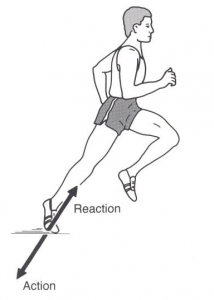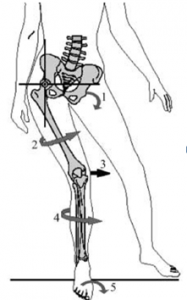Research Review: What Determines Pitching Velocity
Softball pitching performance, the ability to execute multiple pitches with command and velocity, is determined by a combination of technical mastery and physical development. My responsibility, and passion, is to unveil the physical contributors to performance. My goal is to provide information regarding the muscles and muscular teamwork that is required to fulfill the physical abilities that support the acquisition of technical skills.
Before I go further, there are certainly emotional and psychological factors that play an important role in the development of every young athlete. However, that’s not my expertise, so I’ll save that topic for guest posts in the future!
In the remainder of this post, I will review the major physical contributors to softball pitching velocity as suggested by research. I will also provide links to previous posts and videos already on FastpitchPower.com in which I demonstrate exercises and routines that develop the capacities outlined below.
Softball Science Lesson – I have to review the three ways muscles produce force in order for you to appreciate and apply the information below. I also have to define what a “ground reaction force” is, or you might be totally lost.
Muscles work in three ways:
Eccentric Muscle Action – Muscles can generate tension as they are being lengthened. This is referred to as eccentric muscle action. An example of this is your quadriceps muscles during a squat. As you bend your knees, your quads are being stretched but they are also generating enough tension to control the decent of the exercise so you don’t fall to the ground.
Isometric Muscle Action – Muscles can generate tension without an appreciable change in length or joint movement. This is referred to as isometric muscle action and is largely responsible for bringing the body to a halt or stabilizing the skeleton against an external force. An example of this is performing a squat with a pause at the bottom of the movement. If you squat down and hold the position, the tension you feel in your muscles is being caused by isometric muscular actions. Another example of isometric muscle action is the tension you feel in your abdominals during planks.
Concentric Muscle Action – When muscles generate enough tension to overcome an external load, they shorten, which is referred to as concentric muscle action. This type of muscle action is what most people commonly associate with “strength” because it is what allows us to move things. The bench press exercise is a universal example of “overcoming strength”. To lower the bar to your chest requires eccentric strength, however, to push the bar away from your chest demonstrates concentric strength.
Ground Reaction Force – Newton’s Third Law of Motion states for every action there is an equal and opposite reaction. During locomotion, regardless if it’s walking or pitching, when we push into the Earth, the Earth pushes back onto our body. Since the Earth is large and immovable, the equal and opposite force it exerts onto us propels us away from it. Researchers measure GRF, and consequently force expressed by the human into the ground, by utilizing something called a “force plate” which athletes will stand or land on.
Phyiscal Capacities That Determine Softball Pitching Velocity
Research into softball specific mechanics is lacking behind other sports; however, a few studies have provided some insight into the role of specific muscle groups during the windmill delivery and their contribution to performance. Remember, my responsibility is to identify the physical capacities that contribute to performance, not to debate what skills and drills improve performance. In my opinion, here are the three most important contributors to pitching velocity:
1) Rapid acceleration away from the pitching rubber – The researchers in this study examined force expressed into the ground (measured by ground reaction force) by the drive leg and found that the pitchers who pushed away from the rubber with greatest impulse (more force applied in the shortest amount of time) recorded the highest pitching velocities. During the drive phase of the delivery, the muscles of the drive leg act concentrically to push away from the rubber and propel the skeleton toward home plate.
Take Home: Develop a powerful drive leg to throw heat. Impulse, the ability to rapidly apply a lot of force into the ground, is developed by training both force development capacity (strength) and rate of force development capacity (speed). Loaded exercises such as squats enhance force development. Sprinting, skipping, and jumps enhance rate of force development.
2) Rapid deceleration following stride foot contact – Within the same study mentioned above, the researchers examined the forces elicited by and through the stride leg following stride foot contact. The researchers summarized once again that the pitchers who were able to rapidly produce large ground reaction forces recorded the highest pitching velocities. The muscles of the stride leg generate tension (force) to absorb shock and bring the body to a halt. They act eccentrically and isometrically to decelerate the body and redirect the ground reaction force through the leg, into the torso, and out through the pitching arm.
Take home: Emphasize eccentric and isometric muscle actions during functional exercises such as squats and lunges. Eccentric overload is achieved by slowly lowering yourself (taking 4 or more seconds) into the bottom position of the movement. Isometric overload is achieved by pausing at the bottom of the movement before returning to the top.
3) Contribution from the Glute Muscles – In this study, the researchers examined the activity of the glute (butt) muscles throughout the windmill delivery. The researchers reported that pitchers with greater glute activation (utilization) on the drive leg recorded higher pitching velocities.
Ok, now bear with me through the next conclusion. The researchers also reported that the pitchers who elicited the highest vertical ground reaction force through the stride leg following stride foot contract recorded higher pitching velocities. Vertical ground reaction force is a good thing. Large vertical GRF means the force you hit the ground with as you stride toward home plate is being maximally redirected upward into your skeleton. If your core and shoulder is stable, this force will be transferred to the ball. MOST IMPORTANTLY: In order to elicit maximum VGRF, your stride leg must have optimal alignment as it lands, and strength (eccentric and isometric) to CONTROL AND MAINTAIN that alignment. The MUSCLES IN CHARGE OF LOWER BODY ALIGNMENT ARE THE GLUTES! If the hip doesn’t stay “stacked” above the knee, it gives out to the side and force “leaks” out instead of being transmitted to your trunk. This is where the body goes when the glutes are not strong.
Take Home: Strengthen the glutes. Two-leg and one-leg variations of deadlifts, squats, lunges, and hip bridges are the best exercises for glute development that will transfer to softball performance.
Here are three previous posts in which I demonstrate exercises and total body routines that development the physical capacities I’ve described.
Muscles and Exercises You Can’t Pitch Without Part I
Softball Core Training: Where to Begin
The Fastest Way to Increase Running Speed
This is by FAR my most technical contribution to FastpitchPower.com. If you have any questions regarding the information in this post, please drop a comment below and let us start up a conversation!
Ground Reaction Force photo: http://lehmansbaseball.wordpress.com/category/weight-room/
Pronation photo: http://danceadvantage.net/2011/04/14/knee-health/pronation/


What study did you use for this article. trying to find it but link not working. Need help with a paper for class. This article was very helpful and would love to pick your brain just a bit. Any chance you could email me?
Hi Brett, thanks for letting us know the link is broken. Here is a copy of the PDF that I’d saved. Let me know if it doesn’t work.
Worked Great! Thanks for the quick reply… can you point me in any direction for the linear kinematics and kinetics; or angular kinmatics and kinetics of the windmill pitch for dummies? Trying to write a paper on something a little over my head. This above article helps with some and puts it in terms I can understand!
What about glut medius for lateral stability of the hip? I haven’t read your workout pages yet, but just looking at the pictures of the hip and the common fallout laterally would lead me to think that the gluteus medius as well as the other glutes cannot withstand the ground reaction force vertically and laterally within the acetabulum. Now I’m just thinking about it, I’m 45 years old now and when I pitch my high medial ham strings and adductors are always quite sore.
What I was really wondering about was how much strength force is needed in the wrist extensors to withstand the centrifugal force of the pitching windmill motion to maintain maximal wrist extension throughout the ark of motion? Or until wrist flexion begins? How good are you at physics? Michelle
Michelle,
1) The gluteus medius certainly contributes to lateral stability of the hip. I think you will really like this article that demonstrates how much it contributes to stride leg stability.
http://hhpr.uark.edu/biomechanics/KINS/emg_windmill_pictch_jscr2011.pdf
2) I think you mean wrist flexors. The wrist flexors act isometrically and/or eccentrically to control wrist extension throughout the delivery up until release. There is certainly concentric action leading up to release and then eccentric action of the wrist extensors and supinators to decelerate the wrist during the follow through/forearm fire. I think it is a good idea to strengthen the wrist flexors and extensors, yet I’m not sure how essential they are to elite pitching development.
Joe